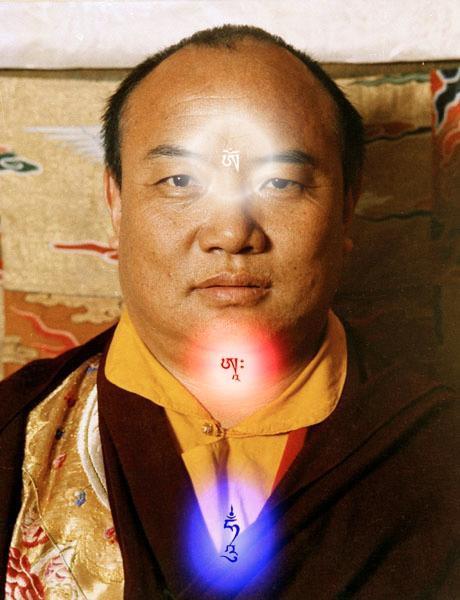In a previous page I detailed the difference between Shiné and Laktong, here I would like to highlight Kyerim and Dzogrim two closely related but very different terms so as to avoid any confusion as to how Vajrayana Tibetan meditations are often structured and how skillfully they have been put together to enable one to work with mind.
Kyerim sounds like Cherim it is the building up or generation phase and is closely linked to the practice of Shiné. One could almost call it Shiné plus, as the student does not just calmly pacify mind or rest mind on an object of meditation, the object of meditation interacts and provides feedback. Through a process called self-initiation, the meditator receives a combination of lights, syllables, and sounds from the object of focus or the Buddha aspect. Sometimes even a feeling is transmitted to the meditator. This feedback is said to trigger subtle psychological changes or responses in mind, the cumulative effect of such feedback is not to be underestimated. A typical example would be as follows: A white light from the Buddha form shines out towards us from an Om syllable on the Buddhas forehead towards our forehead at the same time we and or the group we are meditating with say the syllable Ommmmmmmmmm out loud for a few seconds. We feel or experience the vibration of the light and the sound together. This process is greatly magnified when we meditate in groups especially when we are in very large groups.

Khyrem can be translated to the moment when the Buddha is born. Here the Buddha or Buddha nature is clearly born and activated in our mind. This conscious feedback is also the same feedback one receives in Tibetan empowerments or initiations, albeit with less ritual. This is why this phase is sometimes referred to as self-empowerment as the lights, syllables, and sounds all correspond to the main chakras that are blessed by high Lamas and Rinpoches during an initiation. This self-empowerment provides the meditator with a strong blessing and enlightened contact regardless of where the lama is. One can also use the analogy of tieing ones rapidly changing stream of consciousness to a pole much like you would tie a wild horse to a pole. Within the meditation, one has a series of approved distractions or highly detailed archetypal forms to focus on. Often one can simply rotate ones attention from one specific aspect to another at will within a much smaller field of attention than one is normally used to. These skillful means are very powerful mind training techniques.
Dzogrim or the completion phase can be compared to hugging or uniting ourselves with the Buddha form. The full mixing of powerful light energy and one’s own energy form imbues the meditator with the enlightened qualities of the Buddha aspect and one is filled with blessing. When the term dissolving phase is used it can be understood to be where we dissolve the barrier or distance between us and the enlightened qualities of the lama or Buddha aspect, here one simply feels inseparable from the teacher and all beings. One no longer is looking into the mirror of mind, we are the mirror, reflecting our own enlightened qualities. Perfection phase refers to the total understanding or the absolute realization of Mahamudra the highest teachings in Vajrayana Buddhism. This is a CLEAR experience of mind unadulterated by the veils of our disturbing emotions and basic ignorance. All three are Dzogrim. Dzogrim and Laktong often share the same place and time in most meditations but as Laktong is the insight the “ah ha” moment or the connection to one’s deepest awareness, beyond the normal understanding. Dzogrim clearly points to a pristine unadulterated experience of the LUMINANCE of mind. This CLEAR LIGHT, when seen from an outside perspective but still within the meditative experience, is the mechanism with which mind shines on the form and sound realms in order so that we may perceive them. This responsive outward shining of consciousness is what we are mentally reproducing in the Khyrem part of the meditation. In its very essence, we are the CLEAR LIGHT when there is no longer any distance or barrier between us and our experience and when we have total unity within our experience, sounds perfect doesn’t it?
QP


3 thoughts on “What do Kyerim and Dzogrim mean?”